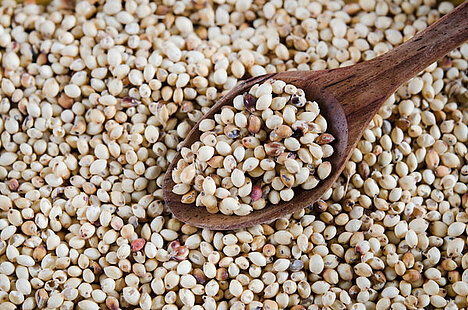Millet

Millet is a small-grain spelt cereal and is one of the oldest cereals in the world. Millet is gluten-free and contains many valuable nutrients such as iron, magnesium, zinc, vitamin B and E. But is millet also suitable for dogs? In this article, you can find out more about the advantages and disadvantages of millet in dog food.
What is millet?
Millet is a collective term for various types of grain from the sweet grass family. The best-known types of millet are panicle millet, foxtail millet, finger millet, pearl millet and sorghum millet. Millet grows in warm and dry areas and is very undemanding and hardy. The grains are surrounded by a hard husk, which must be removed before consumption.
What are the benefits of millet for dogs?
Millet has several benefits for dogs. Firstly, millet is gluten-free and therefore suitable for dogs with gluten intolerance or grain allergies. Secondly, millet is rich in minerals, which are important for the health of skin, coat, bones, teeth, nerves and muscles. Millet is also easily digestible and filling, which can be helpful for dogs with sensitive stomachs or who are overweight.
What are the disadvantages of millet for dogs?
However, millet also has some disadvantages for dogs that should not be ignored. Firstly, millet contains relatively high levels of phytic acid, which can inhibit the absorption of minerals if it is not reduced by soaking or sprouting. Secondly, millet is a source of carbohydrates, which causes blood sugar levels to rise and puts a strain on the pancreas. This can be problematic for dogs with diabetes or a tendency to inflammation. In addition, millet is not a complete substitute for animal protein, which is essential for dogs.
How do I feed my dog millet?
If you want to give your dog millet, you should bear a few points in mind. Firstly, you should soak or sprout the millet beforehand to reduce the phytic acid and improve digestibility. Secondly, you should always offer the millet cooked and cooled, as raw millet is difficult to digest and can cause flatulence. You should also always combine millet with a high-quality protein source such as meat, fish, egg or dairy products to meet your dog's nutritional requirements. Only feed millet in moderation, as it contains a lot of calories and can lead to weight gain.
Millet is a gluten-free grain that has many benefits for dogs, but also some disadvantages. Millet can be a good addition to dog food if it is prepared and dosed correctly. However, you should always pay attention to your dog's individual needs and tolerance.
If you notice any signs of hypersensitivity or poisoning in your dog, you should see your vet immediately. We are not a substitute for a vet, but we try to be as accurate as possible. Every dog reacts differently and we recommend you get a second opinion or consult your vet if in doubt.
Stay healthy and take good care of your four-legged friend!😊
Similar to Millet
Quinoa is a plant from the foxtail family that grows in the Andes. The seeds of the plant are known as quinoa and are similar in shape and consistency to rice or couscous. Quinoa is gluten-free and...
Amaranth is not a real grain, but belongs to the so-called pseudocereals, such as quinoa or buckwheat. This means that it does not contain gluten, which is often responsible for intolerances....
Buckwheat has several benefits for dogs that you should not ignore. For one, buckwheat is a good source of plant-based protein that contains all the essential amino acids. This means that buckwheat...
Bulgur is a cereal product made from durum wheat semolina. To make bulgur, the semolina is soaked, cooked with steam, dried again and the husks removed. The remaining grains are then coarsely or...



